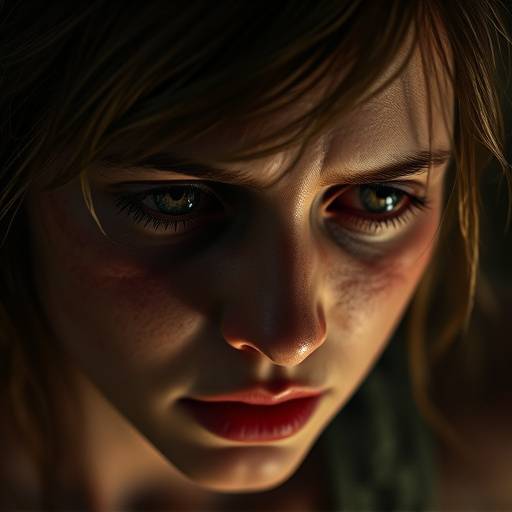Where Art Meets Code: The Evolving Visuals of Gaming
Embark on a journey through the groundbreaking advancements in game graphics, from the stark beauty of minimalism to the profound depths of emotional realism.
Welcome to The Art of Pixels
In the dynamic landscape of digital entertainment, visual design has transcended mere aesthetics to become a cornerstone of player experience. At The Art of Pixels, we delve into the captivating world of video game visual culture, exploring how artists, designers, and technologists are pushing the boundaries of what's possible on screen. Our mission is to illuminate the artistic movements, technical innovations, and psychological principles that shape the way we perceive and interact with virtual worlds. Whether you are a seasoned gamer, an aspiring developer, a visual artist, or simply someone fascinated by the intersection of technology and art, this is your portal to understanding the soul of game visuals.
This site is dedicated to analyzing the aesthetic trends that define modern gaming. We'll traverse the spectrum of visual expression, from the deliberate simplicity of minimalist designs that champion clarity and focus, to the breathtakingly detailed and emotionally charged environments that aim to immerse players in unparalleled realism. We believe that the visual language of games is as rich and complex as any traditional art form, offering unique avenues for storytelling, emotional connection, and profound artistic statement. Join us as we unpack the artistry, innovation, and impact of game visuals.
The Shifting Canvas: A Brief History of Game Visuals
The visual evolution of video games is a story of relentless innovation, driven by both hardware limitations and boundless creative ambition. From the blocky, abstract representations of the arcade era to the photorealistic environments of today, each era has introduced new paradigms in visual design. Early titles relied on simple sprites and limited color palettes, forcing players to engage their imagination to fill in the blanks. This inherent constraint fostered a unique appreciation for clever design and iconic imagery.
As technology advanced, so did the complexity and fidelity of game graphics. The transition to 3D graphics was a monumental leap, opening up vast new possibilities for world-building and immersive experiences. Polygon counts increased, textures became more detailed, and lighting engines grew more sophisticated. This period saw the rise of distinct graphical styles, from the cel-shaded aesthetics of games like The Legend of Zelda: The Wind Waker to the gritty realism of Doom 3 . The goal shifted from suggesting worlds to meticulously crafting them, making them feel tangible and believable.
Today, the pursuit of visual excellence continues. Developers are exploring advanced rendering techniques, real-time ray tracing, and sophisticated animation systems to achieve unprecedented levels of visual fidelity. Yet, amidst this drive for realism, there's a parallel and equally vibrant movement embracing simplification and abstraction. This duality is what makes the current era of game visuals so fascinating.
The Power of Less: Minimalism in Game Design
Minimalism in game visuals is not about a lack of detail; it's about intentionality. It's a design philosophy that strips away the extraneous, focusing on core elements to convey meaning, evoke emotion, and enhance gameplay. Minimalist games often feature clean lines, limited color palettes, geometric shapes, and uncluttered interfaces. This approach can lead to a sense of calm, focus, and elegance, drawing players into the game's mechanics and narrative without overwhelming them.
Consider titles like Journey , which uses vast, empty landscapes and flowing fabrics to create a profound sense of solitude and discovery. Or Monument Valley , with its Escher-esque architectural puzzles presented in a clean, isometric perspective. These games demonstrate how a deliberate reduction of visual elements can amplify their impact. The absence of noise allows players to concentrate on the core experience, fostering a deeper connection with the game's themes and atmosphere. This aesthetic is often celebrated for its timeless quality and its ability to remain visually striking even as technology evolves.
Minimalism can also be a powerful tool for accessibility, making games easier to parse and understand for a wider audience. By focusing on essential visual cues, developers can ensure that players of all abilities can engage with and enjoy their creations. The principles of good minimalist design are rooted in clarity, balance, and purpose, making it a highly effective strategy for crafting memorable and impactful interactive experiences.

The evocative simplicity of Journey .

Architectural elegance in Monument Valley .

The stark atmosphere of Limbo .
The Heart of the Machine: Emotional Realism in Games
While minimalism focuses on reduction, emotional realism aims for an almost overwhelming sense of presence and impact. This design philosophy seeks to create virtual worlds and characters so believable, so nuanced, that they can elicit profound emotional responses from players. It's about crafting experiences that resonate on a deeply human level, making players feel the joy, sorrow, fear, and triumph of the characters they control or encounter.
Emotional realism is achieved through a masterful combination of sophisticated graphical techniques, intricate character animation, nuanced voice acting, and powerful narrative design. Developers meticulously craft environments that feel lived-in, populate them with characters whose motivations and emotions are palpable, and use cinematography and pacing to build tension and evoke empathy. Games like The Last of Us , Red Dead Redemption 2 , and God of War (2018) are prime examples, where hyper-realistic visuals serve to amplify the emotional stakes of their stories.
"The ultimate goal of a truly immersive game is to make the player forget they are playing a game, and instead feel like they are living another life."
This level of realism requires an extraordinary attention to detail. From the subtle flicker of an eyelid conveying doubt to the way rain streaks down a character's face, every element is designed to contribute to the overall emotional tableau. The uncanny valley is a constant challenge, but when overcome, the result is an unforgettable experience that blurs the line between player and protagonist. The power of emotional realism lies in its ability to connect with our deepest human experiences, offering catharsis, reflection, and a profound sense of shared humanity, even within fantastical settings.

Nuanced portrayal of emotion in The Last of Us .

Immersive world-building in Red Dead Redemption 2 .

Visceral impact and character depth in God of War .
Explore the Spectrum
The world of game visuals is a vibrant and ever-expanding universe. Whether you're drawn to the contemplative spaces of minimalist experiences or the heart-pounding immersion of hyper-realistic worlds, there's always something new to discover. We encourage you to explore the other sections of The Art of Pixels:
| Section | Focus | Key Concepts |
|---|---|---|
| Evolution | Tracing the historical progression of game graphics. | Pixel art, 3D rendering, technological milestones, stylistic shifts. |
| Minimalism | Deep dive into minimalist design principles and examples. | Simplicity, clarity, intentionality, color theory, abstract forms. |
| Emotional Realism | Examining how games achieve believable and impactful emotional experiences. | Character fidelity, environmental storytelling, player empathy, narrative integration. |
| Accessibility | How visual design impacts player inclusivity and enjoyment. | Color blindness, visual clutter, customizable UI, cognitive load. |
Understanding these visual philosophies not only enriches your appreciation for the games you play but also provides valuable insights for creators and artists. Each approach, from the deliberate restraint of minimalism to the detailed evocation of emotional realism, serves to enhance the player's journey in unique and powerful ways. Dive deeper and discover the artistry that defines the interactive medium.